Organization Change Management
VerifiedAdded on 2023/06/16
|9
|2589
|116
AI Summary
This article discusses the important features of transformational change undertaken by Lars Kolind and the change processes employed that are fundamental to undertaking organizational transformation. It also talks about the assumed risks and benefits of Spaghetti organization and the management practices or actions required to sustain the revolutionary new culture. The article is relevant to the subject of Organization Change Management and is suitable for students pursuing this course in any college or university.
Contribute Materials
Your contribution can guide someone’s learning journey. Share your
documents today.

Running head: ORGANIZATION CHANGE MANAGEMENT
Organization change management
Name of the student: Tallapaneni Mallikarjuna Rao
Student id: s4587353
Unit Name: Organization change management
Campus: VU Sydney
Organization change management
Name of the student: Tallapaneni Mallikarjuna Rao
Student id: s4587353
Unit Name: Organization change management
Campus: VU Sydney
Secure Best Marks with AI Grader
Need help grading? Try our AI Grader for instant feedback on your assignments.
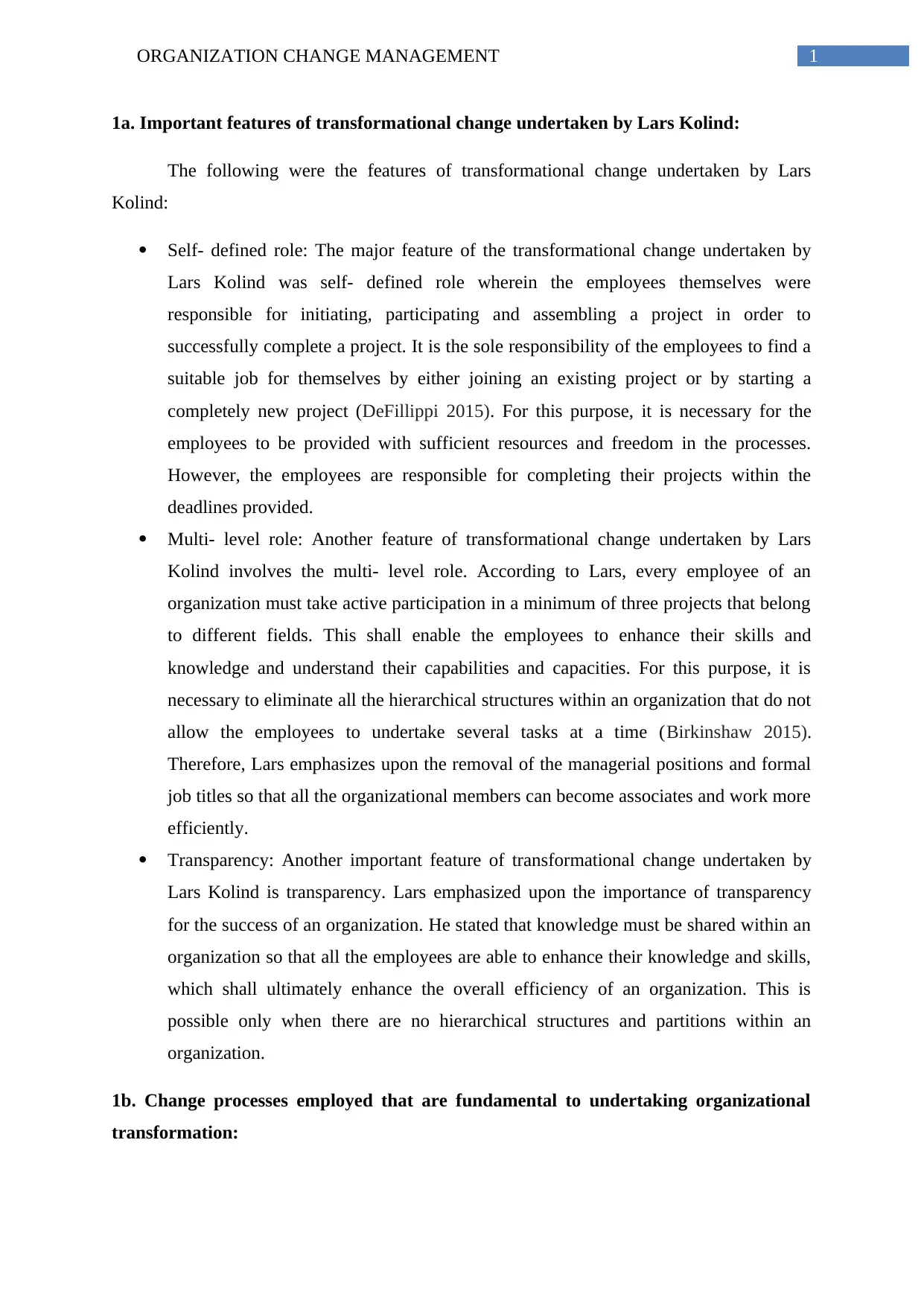
1ORGANIZATION CHANGE MANAGEMENT
1a. Important features of transformational change undertaken by Lars Kolind:
The following were the features of transformational change undertaken by Lars
Kolind:
Self- defined role: The major feature of the transformational change undertaken by
Lars Kolind was self- defined role wherein the employees themselves were
responsible for initiating, participating and assembling a project in order to
successfully complete a project. It is the sole responsibility of the employees to find a
suitable job for themselves by either joining an existing project or by starting a
completely new project (DeFillippi 2015). For this purpose, it is necessary for the
employees to be provided with sufficient resources and freedom in the processes.
However, the employees are responsible for completing their projects within the
deadlines provided.
Multi- level role: Another feature of transformational change undertaken by Lars
Kolind involves the multi- level role. According to Lars, every employee of an
organization must take active participation in a minimum of three projects that belong
to different fields. This shall enable the employees to enhance their skills and
knowledge and understand their capabilities and capacities. For this purpose, it is
necessary to eliminate all the hierarchical structures within an organization that do not
allow the employees to undertake several tasks at a time (Birkinshaw 2015).
Therefore, Lars emphasizes upon the removal of the managerial positions and formal
job titles so that all the organizational members can become associates and work more
efficiently.
Transparency: Another important feature of transformational change undertaken by
Lars Kolind is transparency. Lars emphasized upon the importance of transparency
for the success of an organization. He stated that knowledge must be shared within an
organization so that all the employees are able to enhance their knowledge and skills,
which shall ultimately enhance the overall efficiency of an organization. This is
possible only when there are no hierarchical structures and partitions within an
organization.
1b. Change processes employed that are fundamental to undertaking organizational
transformation:
1a. Important features of transformational change undertaken by Lars Kolind:
The following were the features of transformational change undertaken by Lars
Kolind:
Self- defined role: The major feature of the transformational change undertaken by
Lars Kolind was self- defined role wherein the employees themselves were
responsible for initiating, participating and assembling a project in order to
successfully complete a project. It is the sole responsibility of the employees to find a
suitable job for themselves by either joining an existing project or by starting a
completely new project (DeFillippi 2015). For this purpose, it is necessary for the
employees to be provided with sufficient resources and freedom in the processes.
However, the employees are responsible for completing their projects within the
deadlines provided.
Multi- level role: Another feature of transformational change undertaken by Lars
Kolind involves the multi- level role. According to Lars, every employee of an
organization must take active participation in a minimum of three projects that belong
to different fields. This shall enable the employees to enhance their skills and
knowledge and understand their capabilities and capacities. For this purpose, it is
necessary to eliminate all the hierarchical structures within an organization that do not
allow the employees to undertake several tasks at a time (Birkinshaw 2015).
Therefore, Lars emphasizes upon the removal of the managerial positions and formal
job titles so that all the organizational members can become associates and work more
efficiently.
Transparency: Another important feature of transformational change undertaken by
Lars Kolind is transparency. Lars emphasized upon the importance of transparency
for the success of an organization. He stated that knowledge must be shared within an
organization so that all the employees are able to enhance their knowledge and skills,
which shall ultimately enhance the overall efficiency of an organization. This is
possible only when there are no hierarchical structures and partitions within an
organization.
1b. Change processes employed that are fundamental to undertaking organizational
transformation:
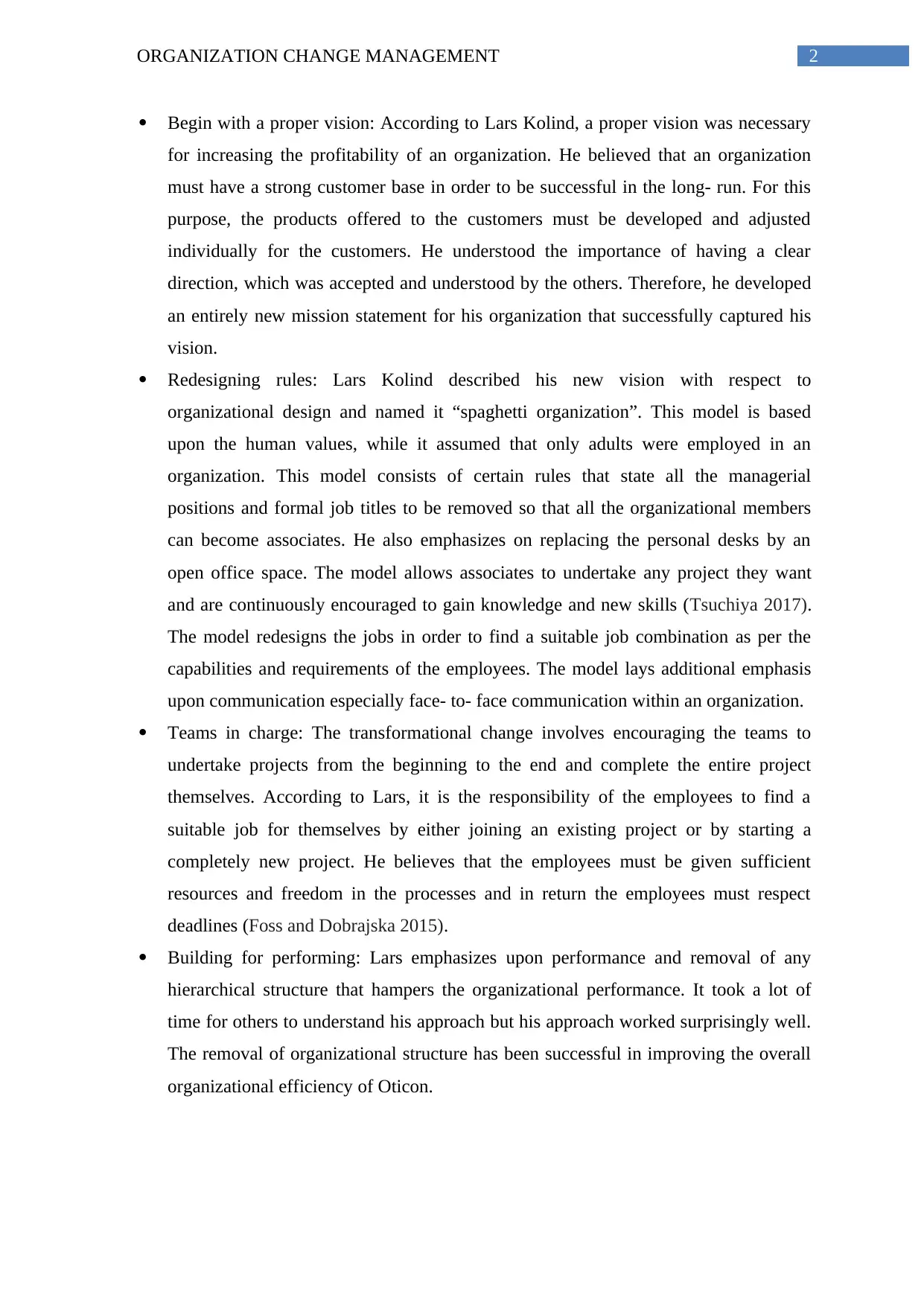
2ORGANIZATION CHANGE MANAGEMENT
Begin with a proper vision: According to Lars Kolind, a proper vision was necessary
for increasing the profitability of an organization. He believed that an organization
must have a strong customer base in order to be successful in the long- run. For this
purpose, the products offered to the customers must be developed and adjusted
individually for the customers. He understood the importance of having a clear
direction, which was accepted and understood by the others. Therefore, he developed
an entirely new mission statement for his organization that successfully captured his
vision.
Redesigning rules: Lars Kolind described his new vision with respect to
organizational design and named it “spaghetti organization”. This model is based
upon the human values, while it assumed that only adults were employed in an
organization. This model consists of certain rules that state all the managerial
positions and formal job titles to be removed so that all the organizational members
can become associates. He also emphasizes on replacing the personal desks by an
open office space. The model allows associates to undertake any project they want
and are continuously encouraged to gain knowledge and new skills (Tsuchiya 2017).
The model redesigns the jobs in order to find a suitable job combination as per the
capabilities and requirements of the employees. The model lays additional emphasis
upon communication especially face- to- face communication within an organization.
Teams in charge: The transformational change involves encouraging the teams to
undertake projects from the beginning to the end and complete the entire project
themselves. According to Lars, it is the responsibility of the employees to find a
suitable job for themselves by either joining an existing project or by starting a
completely new project. He believes that the employees must be given sufficient
resources and freedom in the processes and in return the employees must respect
deadlines (Foss and Dobrajska 2015).
Building for performing: Lars emphasizes upon performance and removal of any
hierarchical structure that hampers the organizational performance. It took a lot of
time for others to understand his approach but his approach worked surprisingly well.
The removal of organizational structure has been successful in improving the overall
organizational efficiency of Oticon.
Begin with a proper vision: According to Lars Kolind, a proper vision was necessary
for increasing the profitability of an organization. He believed that an organization
must have a strong customer base in order to be successful in the long- run. For this
purpose, the products offered to the customers must be developed and adjusted
individually for the customers. He understood the importance of having a clear
direction, which was accepted and understood by the others. Therefore, he developed
an entirely new mission statement for his organization that successfully captured his
vision.
Redesigning rules: Lars Kolind described his new vision with respect to
organizational design and named it “spaghetti organization”. This model is based
upon the human values, while it assumed that only adults were employed in an
organization. This model consists of certain rules that state all the managerial
positions and formal job titles to be removed so that all the organizational members
can become associates. He also emphasizes on replacing the personal desks by an
open office space. The model allows associates to undertake any project they want
and are continuously encouraged to gain knowledge and new skills (Tsuchiya 2017).
The model redesigns the jobs in order to find a suitable job combination as per the
capabilities and requirements of the employees. The model lays additional emphasis
upon communication especially face- to- face communication within an organization.
Teams in charge: The transformational change involves encouraging the teams to
undertake projects from the beginning to the end and complete the entire project
themselves. According to Lars, it is the responsibility of the employees to find a
suitable job for themselves by either joining an existing project or by starting a
completely new project. He believes that the employees must be given sufficient
resources and freedom in the processes and in return the employees must respect
deadlines (Foss and Dobrajska 2015).
Building for performing: Lars emphasizes upon performance and removal of any
hierarchical structure that hampers the organizational performance. It took a lot of
time for others to understand his approach but his approach worked surprisingly well.
The removal of organizational structure has been successful in improving the overall
organizational efficiency of Oticon.
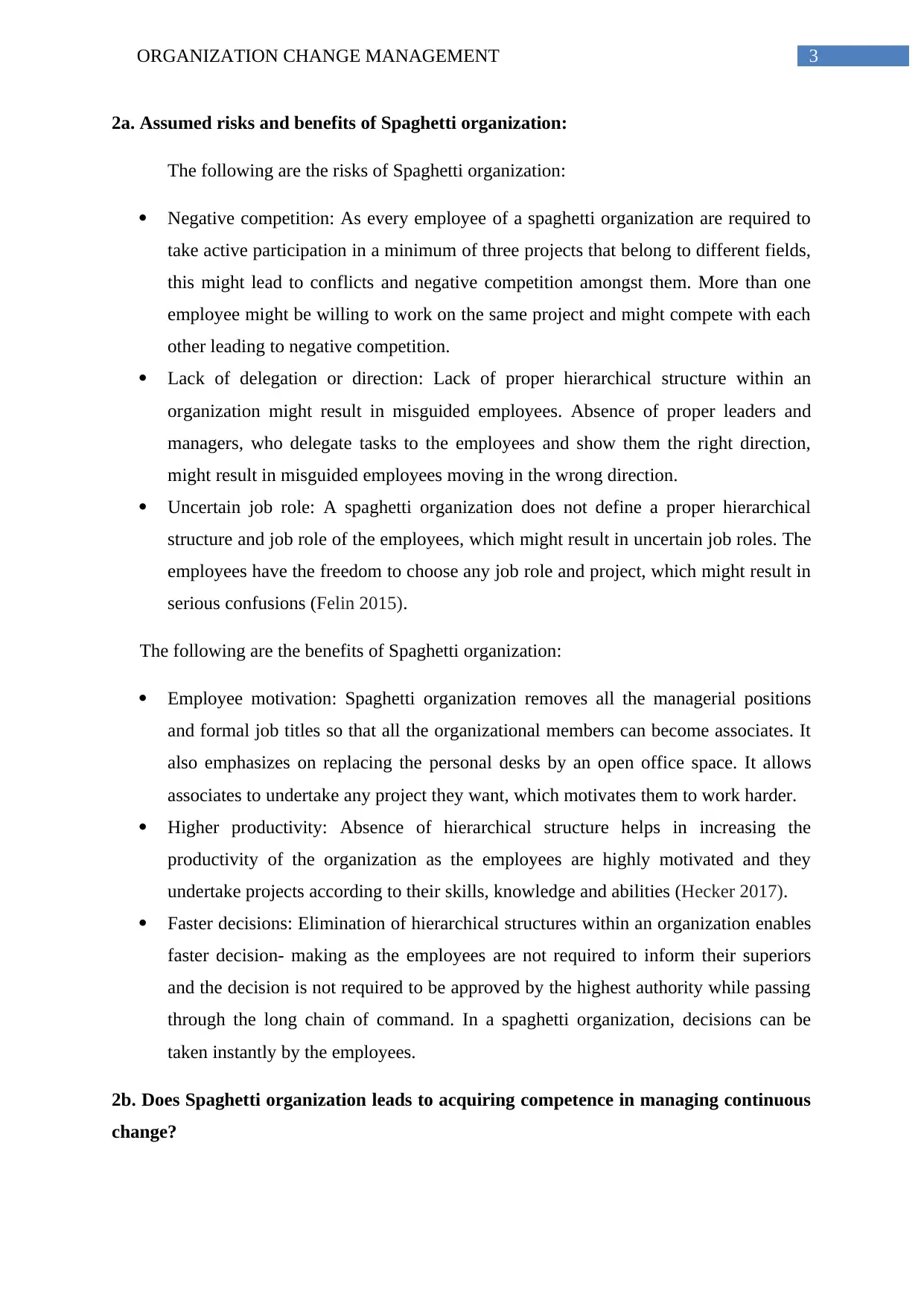
3ORGANIZATION CHANGE MANAGEMENT
2a. Assumed risks and benefits of Spaghetti organization:
The following are the risks of Spaghetti organization:
Negative competition: As every employee of a spaghetti organization are required to
take active participation in a minimum of three projects that belong to different fields,
this might lead to conflicts and negative competition amongst them. More than one
employee might be willing to work on the same project and might compete with each
other leading to negative competition.
Lack of delegation or direction: Lack of proper hierarchical structure within an
organization might result in misguided employees. Absence of proper leaders and
managers, who delegate tasks to the employees and show them the right direction,
might result in misguided employees moving in the wrong direction.
Uncertain job role: A spaghetti organization does not define a proper hierarchical
structure and job role of the employees, which might result in uncertain job roles. The
employees have the freedom to choose any job role and project, which might result in
serious confusions (Felin 2015).
The following are the benefits of Spaghetti organization:
Employee motivation: Spaghetti organization removes all the managerial positions
and formal job titles so that all the organizational members can become associates. It
also emphasizes on replacing the personal desks by an open office space. It allows
associates to undertake any project they want, which motivates them to work harder.
Higher productivity: Absence of hierarchical structure helps in increasing the
productivity of the organization as the employees are highly motivated and they
undertake projects according to their skills, knowledge and abilities (Hecker 2017).
Faster decisions: Elimination of hierarchical structures within an organization enables
faster decision- making as the employees are not required to inform their superiors
and the decision is not required to be approved by the highest authority while passing
through the long chain of command. In a spaghetti organization, decisions can be
taken instantly by the employees.
2b. Does Spaghetti organization leads to acquiring competence in managing continuous
change?
2a. Assumed risks and benefits of Spaghetti organization:
The following are the risks of Spaghetti organization:
Negative competition: As every employee of a spaghetti organization are required to
take active participation in a minimum of three projects that belong to different fields,
this might lead to conflicts and negative competition amongst them. More than one
employee might be willing to work on the same project and might compete with each
other leading to negative competition.
Lack of delegation or direction: Lack of proper hierarchical structure within an
organization might result in misguided employees. Absence of proper leaders and
managers, who delegate tasks to the employees and show them the right direction,
might result in misguided employees moving in the wrong direction.
Uncertain job role: A spaghetti organization does not define a proper hierarchical
structure and job role of the employees, which might result in uncertain job roles. The
employees have the freedom to choose any job role and project, which might result in
serious confusions (Felin 2015).
The following are the benefits of Spaghetti organization:
Employee motivation: Spaghetti organization removes all the managerial positions
and formal job titles so that all the organizational members can become associates. It
also emphasizes on replacing the personal desks by an open office space. It allows
associates to undertake any project they want, which motivates them to work harder.
Higher productivity: Absence of hierarchical structure helps in increasing the
productivity of the organization as the employees are highly motivated and they
undertake projects according to their skills, knowledge and abilities (Hecker 2017).
Faster decisions: Elimination of hierarchical structures within an organization enables
faster decision- making as the employees are not required to inform their superiors
and the decision is not required to be approved by the highest authority while passing
through the long chain of command. In a spaghetti organization, decisions can be
taken instantly by the employees.
2b. Does Spaghetti organization leads to acquiring competence in managing continuous
change?
Secure Best Marks with AI Grader
Need help grading? Try our AI Grader for instant feedback on your assignments.
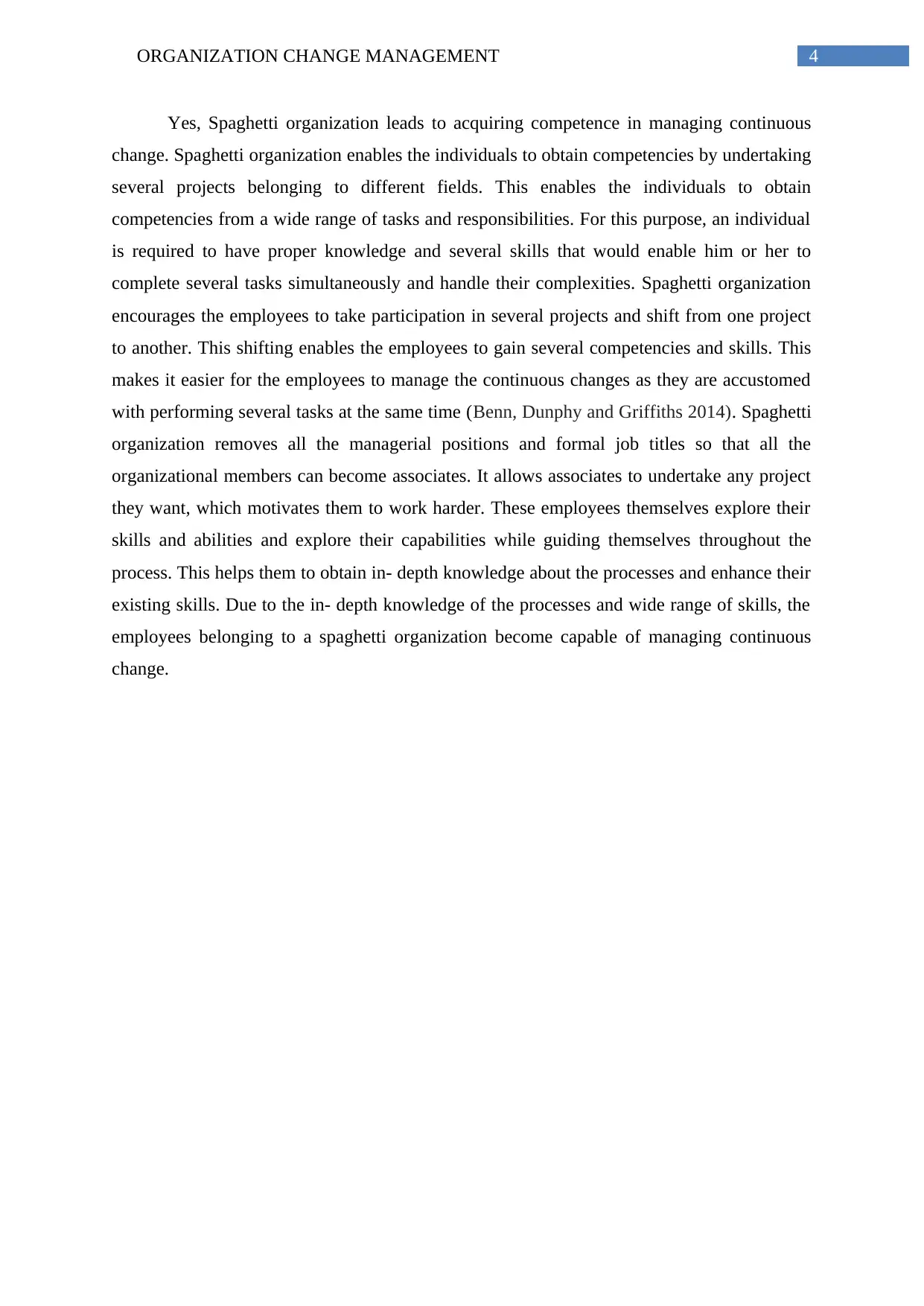
4ORGANIZATION CHANGE MANAGEMENT
Yes, Spaghetti organization leads to acquiring competence in managing continuous
change. Spaghetti organization enables the individuals to obtain competencies by undertaking
several projects belonging to different fields. This enables the individuals to obtain
competencies from a wide range of tasks and responsibilities. For this purpose, an individual
is required to have proper knowledge and several skills that would enable him or her to
complete several tasks simultaneously and handle their complexities. Spaghetti organization
encourages the employees to take participation in several projects and shift from one project
to another. This shifting enables the employees to gain several competencies and skills. This
makes it easier for the employees to manage the continuous changes as they are accustomed
with performing several tasks at the same time (Benn, Dunphy and Griffiths 2014). Spaghetti
organization removes all the managerial positions and formal job titles so that all the
organizational members can become associates. It allows associates to undertake any project
they want, which motivates them to work harder. These employees themselves explore their
skills and abilities and explore their capabilities while guiding themselves throughout the
process. This helps them to obtain in- depth knowledge about the processes and enhance their
existing skills. Due to the in- depth knowledge of the processes and wide range of skills, the
employees belonging to a spaghetti organization become capable of managing continuous
change.
Yes, Spaghetti organization leads to acquiring competence in managing continuous
change. Spaghetti organization enables the individuals to obtain competencies by undertaking
several projects belonging to different fields. This enables the individuals to obtain
competencies from a wide range of tasks and responsibilities. For this purpose, an individual
is required to have proper knowledge and several skills that would enable him or her to
complete several tasks simultaneously and handle their complexities. Spaghetti organization
encourages the employees to take participation in several projects and shift from one project
to another. This shifting enables the employees to gain several competencies and skills. This
makes it easier for the employees to manage the continuous changes as they are accustomed
with performing several tasks at the same time (Benn, Dunphy and Griffiths 2014). Spaghetti
organization removes all the managerial positions and formal job titles so that all the
organizational members can become associates. It allows associates to undertake any project
they want, which motivates them to work harder. These employees themselves explore their
skills and abilities and explore their capabilities while guiding themselves throughout the
process. This helps them to obtain in- depth knowledge about the processes and enhance their
existing skills. Due to the in- depth knowledge of the processes and wide range of skills, the
employees belonging to a spaghetti organization become capable of managing continuous
change.
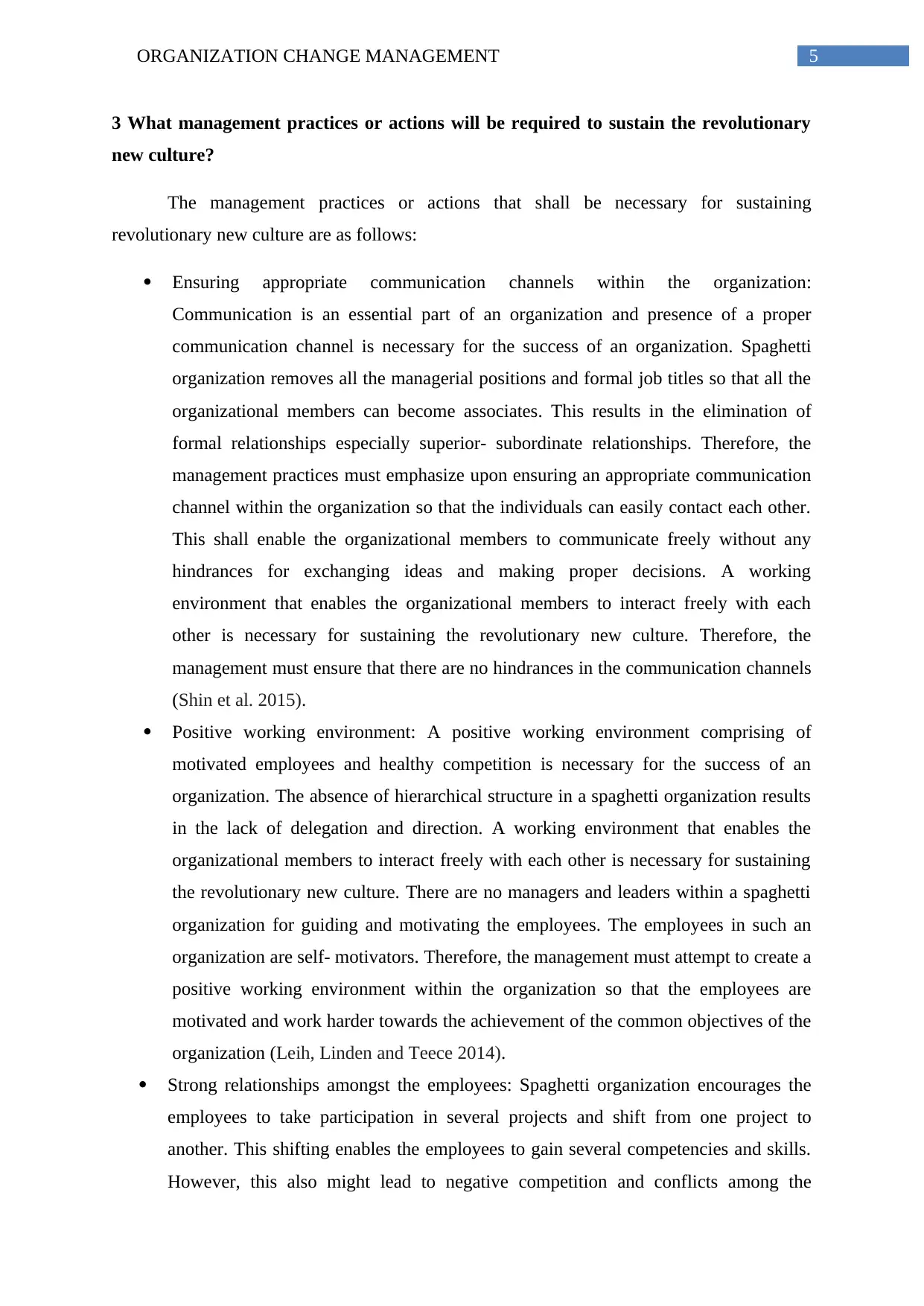
5ORGANIZATION CHANGE MANAGEMENT
3 What management practices or actions will be required to sustain the revolutionary
new culture?
The management practices or actions that shall be necessary for sustaining
revolutionary new culture are as follows:
Ensuring appropriate communication channels within the organization:
Communication is an essential part of an organization and presence of a proper
communication channel is necessary for the success of an organization. Spaghetti
organization removes all the managerial positions and formal job titles so that all the
organizational members can become associates. This results in the elimination of
formal relationships especially superior- subordinate relationships. Therefore, the
management practices must emphasize upon ensuring an appropriate communication
channel within the organization so that the individuals can easily contact each other.
This shall enable the organizational members to communicate freely without any
hindrances for exchanging ideas and making proper decisions. A working
environment that enables the organizational members to interact freely with each
other is necessary for sustaining the revolutionary new culture. Therefore, the
management must ensure that there are no hindrances in the communication channels
(Shin et al. 2015).
Positive working environment: A positive working environment comprising of
motivated employees and healthy competition is necessary for the success of an
organization. The absence of hierarchical structure in a spaghetti organization results
in the lack of delegation and direction. A working environment that enables the
organizational members to interact freely with each other is necessary for sustaining
the revolutionary new culture. There are no managers and leaders within a spaghetti
organization for guiding and motivating the employees. The employees in such an
organization are self- motivators. Therefore, the management must attempt to create a
positive working environment within the organization so that the employees are
motivated and work harder towards the achievement of the common objectives of the
organization (Leih, Linden and Teece 2014).
Strong relationships amongst the employees: Spaghetti organization encourages the
employees to take participation in several projects and shift from one project to
another. This shifting enables the employees to gain several competencies and skills.
However, this also might lead to negative competition and conflicts among the
3 What management practices or actions will be required to sustain the revolutionary
new culture?
The management practices or actions that shall be necessary for sustaining
revolutionary new culture are as follows:
Ensuring appropriate communication channels within the organization:
Communication is an essential part of an organization and presence of a proper
communication channel is necessary for the success of an organization. Spaghetti
organization removes all the managerial positions and formal job titles so that all the
organizational members can become associates. This results in the elimination of
formal relationships especially superior- subordinate relationships. Therefore, the
management practices must emphasize upon ensuring an appropriate communication
channel within the organization so that the individuals can easily contact each other.
This shall enable the organizational members to communicate freely without any
hindrances for exchanging ideas and making proper decisions. A working
environment that enables the organizational members to interact freely with each
other is necessary for sustaining the revolutionary new culture. Therefore, the
management must ensure that there are no hindrances in the communication channels
(Shin et al. 2015).
Positive working environment: A positive working environment comprising of
motivated employees and healthy competition is necessary for the success of an
organization. The absence of hierarchical structure in a spaghetti organization results
in the lack of delegation and direction. A working environment that enables the
organizational members to interact freely with each other is necessary for sustaining
the revolutionary new culture. There are no managers and leaders within a spaghetti
organization for guiding and motivating the employees. The employees in such an
organization are self- motivators. Therefore, the management must attempt to create a
positive working environment within the organization so that the employees are
motivated and work harder towards the achievement of the common objectives of the
organization (Leih, Linden and Teece 2014).
Strong relationships amongst the employees: Spaghetti organization encourages the
employees to take participation in several projects and shift from one project to
another. This shifting enables the employees to gain several competencies and skills.
However, this also might lead to negative competition and conflicts among the
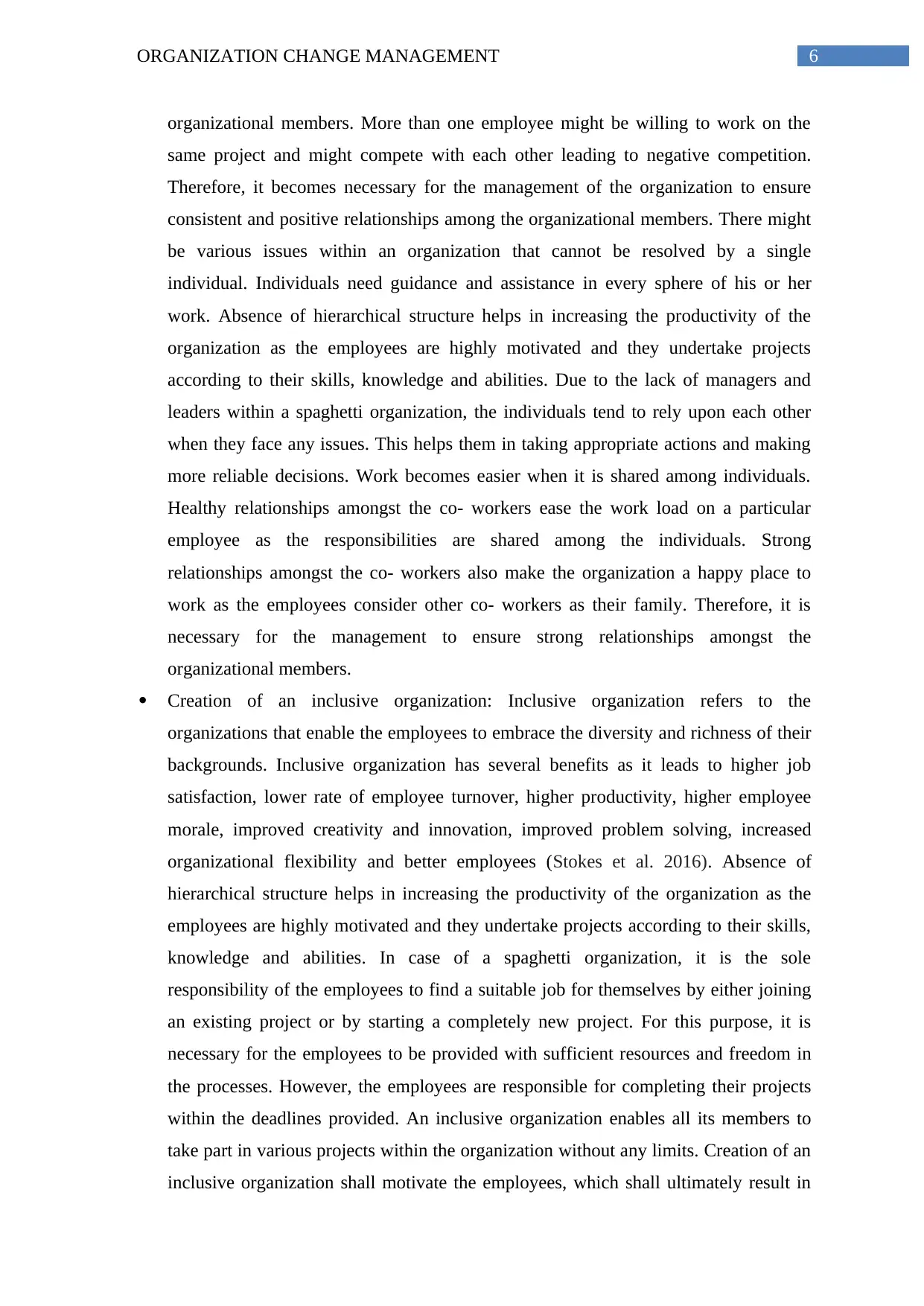
6ORGANIZATION CHANGE MANAGEMENT
organizational members. More than one employee might be willing to work on the
same project and might compete with each other leading to negative competition.
Therefore, it becomes necessary for the management of the organization to ensure
consistent and positive relationships among the organizational members. There might
be various issues within an organization that cannot be resolved by a single
individual. Individuals need guidance and assistance in every sphere of his or her
work. Absence of hierarchical structure helps in increasing the productivity of the
organization as the employees are highly motivated and they undertake projects
according to their skills, knowledge and abilities. Due to the lack of managers and
leaders within a spaghetti organization, the individuals tend to rely upon each other
when they face any issues. This helps them in taking appropriate actions and making
more reliable decisions. Work becomes easier when it is shared among individuals.
Healthy relationships amongst the co- workers ease the work load on a particular
employee as the responsibilities are shared among the individuals. Strong
relationships amongst the co- workers also make the organization a happy place to
work as the employees consider other co- workers as their family. Therefore, it is
necessary for the management to ensure strong relationships amongst the
organizational members.
Creation of an inclusive organization: Inclusive organization refers to the
organizations that enable the employees to embrace the diversity and richness of their
backgrounds. Inclusive organization has several benefits as it leads to higher job
satisfaction, lower rate of employee turnover, higher productivity, higher employee
morale, improved creativity and innovation, improved problem solving, increased
organizational flexibility and better employees (Stokes et al. 2016). Absence of
hierarchical structure helps in increasing the productivity of the organization as the
employees are highly motivated and they undertake projects according to their skills,
knowledge and abilities. In case of a spaghetti organization, it is the sole
responsibility of the employees to find a suitable job for themselves by either joining
an existing project or by starting a completely new project. For this purpose, it is
necessary for the employees to be provided with sufficient resources and freedom in
the processes. However, the employees are responsible for completing their projects
within the deadlines provided. An inclusive organization enables all its members to
take part in various projects within the organization without any limits. Creation of an
inclusive organization shall motivate the employees, which shall ultimately result in
organizational members. More than one employee might be willing to work on the
same project and might compete with each other leading to negative competition.
Therefore, it becomes necessary for the management of the organization to ensure
consistent and positive relationships among the organizational members. There might
be various issues within an organization that cannot be resolved by a single
individual. Individuals need guidance and assistance in every sphere of his or her
work. Absence of hierarchical structure helps in increasing the productivity of the
organization as the employees are highly motivated and they undertake projects
according to their skills, knowledge and abilities. Due to the lack of managers and
leaders within a spaghetti organization, the individuals tend to rely upon each other
when they face any issues. This helps them in taking appropriate actions and making
more reliable decisions. Work becomes easier when it is shared among individuals.
Healthy relationships amongst the co- workers ease the work load on a particular
employee as the responsibilities are shared among the individuals. Strong
relationships amongst the co- workers also make the organization a happy place to
work as the employees consider other co- workers as their family. Therefore, it is
necessary for the management to ensure strong relationships amongst the
organizational members.
Creation of an inclusive organization: Inclusive organization refers to the
organizations that enable the employees to embrace the diversity and richness of their
backgrounds. Inclusive organization has several benefits as it leads to higher job
satisfaction, lower rate of employee turnover, higher productivity, higher employee
morale, improved creativity and innovation, improved problem solving, increased
organizational flexibility and better employees (Stokes et al. 2016). Absence of
hierarchical structure helps in increasing the productivity of the organization as the
employees are highly motivated and they undertake projects according to their skills,
knowledge and abilities. In case of a spaghetti organization, it is the sole
responsibility of the employees to find a suitable job for themselves by either joining
an existing project or by starting a completely new project. For this purpose, it is
necessary for the employees to be provided with sufficient resources and freedom in
the processes. However, the employees are responsible for completing their projects
within the deadlines provided. An inclusive organization enables all its members to
take part in various projects within the organization without any limits. Creation of an
inclusive organization shall motivate the employees, which shall ultimately result in
Paraphrase This Document
Need a fresh take? Get an instant paraphrase of this document with our AI Paraphraser
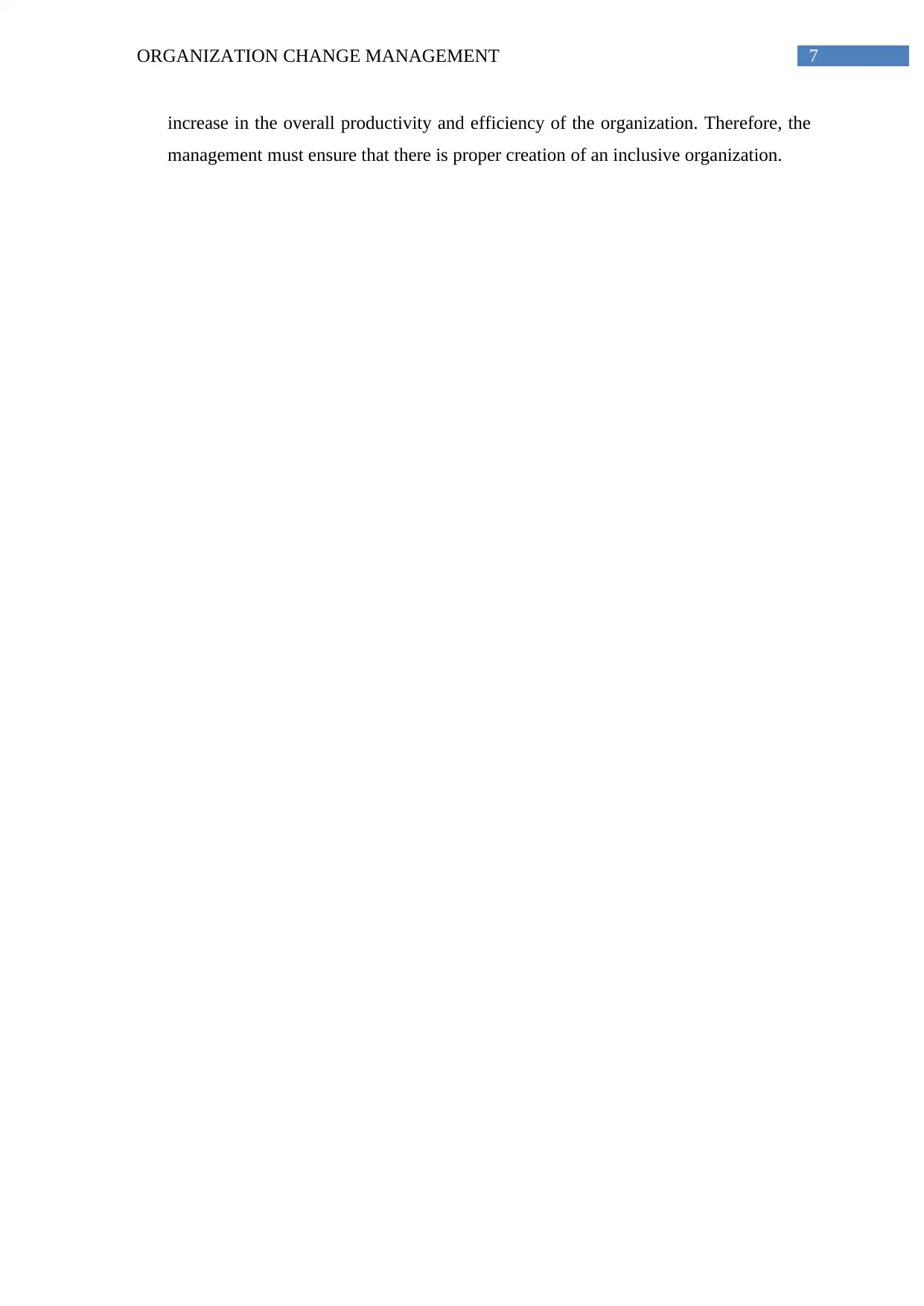
7ORGANIZATION CHANGE MANAGEMENT
increase in the overall productivity and efficiency of the organization. Therefore, the
management must ensure that there is proper creation of an inclusive organization.
increase in the overall productivity and efficiency of the organization. Therefore, the
management must ensure that there is proper creation of an inclusive organization.
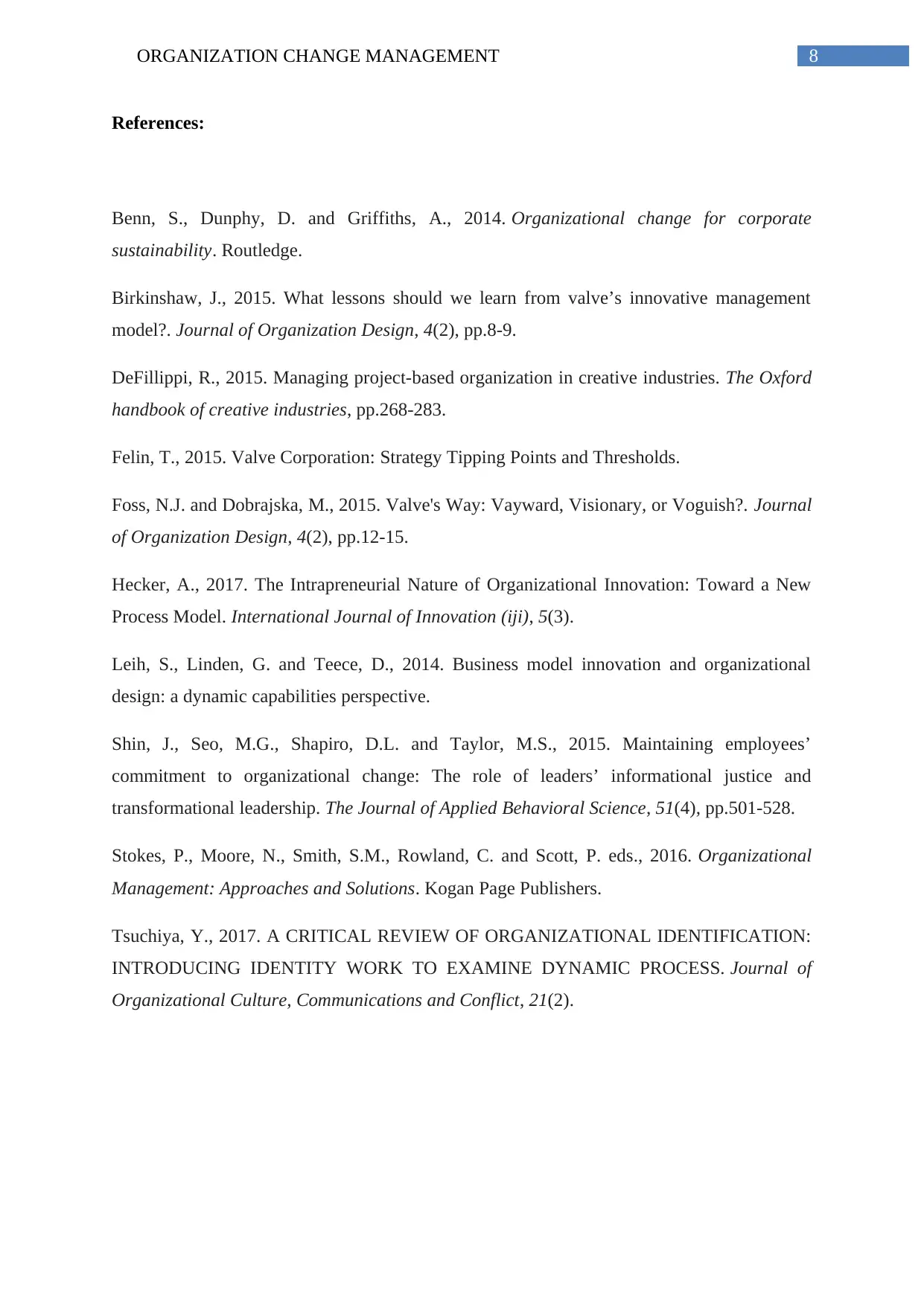
8ORGANIZATION CHANGE MANAGEMENT
References:
Benn, S., Dunphy, D. and Griffiths, A., 2014. Organizational change for corporate
sustainability. Routledge.
Birkinshaw, J., 2015. What lessons should we learn from valve’s innovative management
model?. Journal of Organization Design, 4(2), pp.8-9.
DeFillippi, R., 2015. Managing project-based organization in creative industries. The Oxford
handbook of creative industries, pp.268-283.
Felin, T., 2015. Valve Corporation: Strategy Tipping Points and Thresholds.
Foss, N.J. and Dobrajska, M., 2015. Valve's Way: Vayward, Visionary, or Voguish?. Journal
of Organization Design, 4(2), pp.12-15.
Hecker, A., 2017. The Intrapreneurial Nature of Organizational Innovation: Toward a New
Process Model. International Journal of Innovation (iji), 5(3).
Leih, S., Linden, G. and Teece, D., 2014. Business model innovation and organizational
design: a dynamic capabilities perspective.
Shin, J., Seo, M.G., Shapiro, D.L. and Taylor, M.S., 2015. Maintaining employees’
commitment to organizational change: The role of leaders’ informational justice and
transformational leadership. The Journal of Applied Behavioral Science, 51(4), pp.501-528.
Stokes, P., Moore, N., Smith, S.M., Rowland, C. and Scott, P. eds., 2016. Organizational
Management: Approaches and Solutions. Kogan Page Publishers.
Tsuchiya, Y., 2017. A CRITICAL REVIEW OF ORGANIZATIONAL IDENTIFICATION:
INTRODUCING IDENTITY WORK TO EXAMINE DYNAMIC PROCESS. Journal of
Organizational Culture, Communications and Conflict, 21(2).
References:
Benn, S., Dunphy, D. and Griffiths, A., 2014. Organizational change for corporate
sustainability. Routledge.
Birkinshaw, J., 2015. What lessons should we learn from valve’s innovative management
model?. Journal of Organization Design, 4(2), pp.8-9.
DeFillippi, R., 2015. Managing project-based organization in creative industries. The Oxford
handbook of creative industries, pp.268-283.
Felin, T., 2015. Valve Corporation: Strategy Tipping Points and Thresholds.
Foss, N.J. and Dobrajska, M., 2015. Valve's Way: Vayward, Visionary, or Voguish?. Journal
of Organization Design, 4(2), pp.12-15.
Hecker, A., 2017. The Intrapreneurial Nature of Organizational Innovation: Toward a New
Process Model. International Journal of Innovation (iji), 5(3).
Leih, S., Linden, G. and Teece, D., 2014. Business model innovation and organizational
design: a dynamic capabilities perspective.
Shin, J., Seo, M.G., Shapiro, D.L. and Taylor, M.S., 2015. Maintaining employees’
commitment to organizational change: The role of leaders’ informational justice and
transformational leadership. The Journal of Applied Behavioral Science, 51(4), pp.501-528.
Stokes, P., Moore, N., Smith, S.M., Rowland, C. and Scott, P. eds., 2016. Organizational
Management: Approaches and Solutions. Kogan Page Publishers.
Tsuchiya, Y., 2017. A CRITICAL REVIEW OF ORGANIZATIONAL IDENTIFICATION:
INTRODUCING IDENTITY WORK TO EXAMINE DYNAMIC PROCESS. Journal of
Organizational Culture, Communications and Conflict, 21(2).
1 out of 9
Related Documents
Your All-in-One AI-Powered Toolkit for Academic Success.
+13062052269
info@desklib.com
Available 24*7 on WhatsApp / Email
![[object Object]](/_next/static/media/star-bottom.7253800d.svg)
Unlock your academic potential
© 2024 | Zucol Services PVT LTD | All rights reserved.





